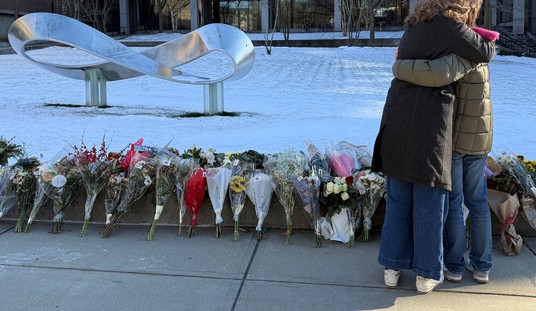By Michael J. Totten
Frederick and Kimberly Kagan have written a very worthwhile piece about the strategy underpinning the United States military’s surge in Iraq.
The new strategy for Iraq has entered its second phase. Now that all of the additional combat forces have arrived in theater, Generals David Petraeus and Ray Odierno have begun Operation Phantom Thunder, a vast and complex effort to disrupt al Qaeda and Shiite militia bases all around Baghdad in advance of the major clear-and-hold operations that will follow. The deployment of forces and preparations for this operation have gone better than expected, and Phantom Thunder is so far proceeding very well. All aspects of the current strategy have been built upon the lessons of previous successful and unsuccessful Coalition efforts to establish security in Iraq, and there is every reason to be optimistic about its outcome.
I’ll be honest here. “Optimism” and “Iraq” in the same sentence sound ludicrous to me unless we’re talking about Kurdistan. Too many times I naively believed the U.S. was “turning the corner” on the insurgency, only to later feel like a sucker. Don’t be a sucker is perhaps the best one-sentence advice I can give to anyone who chooses to engage or even dabble in Middle East politics. I learned that one several times from experience.
At the same time, though, I know that conflict does not equal failure. And lack of victory in the middle of a war doesn’t pre-ordain failure at the end of a war. Otherwise it would not be the middle.
Insurgencies are monstrous things. A few days ago Algerian Minister of Culture Khalida Toum said the Islamist insurgency war in that country, which killed 150,000 people and is only just now winding down, was like “ten years of 9/11 and nobody offered their condolences.”
Some insurgencies are broken in less than ten years. Israel put down the Palestinian intifada much quicker than that. The Lebanese Army, which is terribly weak, has mostly eliminated Syria’s proxy Fatah Al Islam in less than two months. So who knows? Maybe the U.S. will pull it off.
So many mistakes have been made in Iraq that I don’t even know how to count them. I’m also, to again be totally honest, not qualified to judge every mistake as a mistake. I’m not an ignoramus about the military and war, but I’m far indeed from being a general. And the only war zone I’ve been to in Iraq so far is Kirkuk.
What’s encouraging about the surge is that it’s the product of a hard learning experience from American military commanders who have been watching what works and what doesn’t.
The essay by the two Kagans is worth reading in its entirety because they analyze the military’s past mistakes and show how the lessons learned then are being applied to the surge now. They look at the botched and successful campaigns in Fallujah, Najaf, Sadr City, Tal Afar, the Upper Euphrates, Ramadi, and Baghdad.
Here is what they wrote about Ramadi:
Early in 2006, the U.S. military command withdrew the additional forces introduced to support the elections, and thereafter resisted all suggestions of a more active posture or a larger American presence. In 2006 the focus was on training the Iraqi military and transitioning responsibility for security to the Iraqis. It was hoped that the results of the 2005 elections would lead to the political progress that was seen as the key to reducing violence, and Generals John Abizaid and George Casey believed that an active American presence was an irritant that caused more trouble than it cured. They also feared that American forces conducting counterinsurgency operations would allow the Iraqi forces to lie back and become dependent on the Coalition. The overall U.S. posture in the first half of 2006, therefore, remained largely defensive and reactive, and the military command aimed to reduce the number of American forces in Iraq as rapidly as possible.
In the meantime, the situation was deteriorating dramatically. Al Qaeda terrorists destroyed the Golden Dome of the al-Askariya Mosque in Samarra (a Shiite shrine in the predominantly Sunni Arab province of Salahuddin), and a wave of sectarian violence swept Iraq. Within days more than 30 mosques had been bombed, and death squads began executing civilians across the country in large numbers in tit-for-tat sectarian murders.
The failure to follow up either on the successes in Falluja in 2004 or on the beginnings of clearing operations in the Upper Euphrates in 2005 allowed Anbar Province to sink deeper into the control of Sunni insurgents and al Qaeda terrorists. As late as August 2006, the Marine intelligence officer for the province declared that it was irretrievably lost to the enemy.
Nevertheless, the Marines and Army units in Anbar began a series of quiet efforts to regain control that ultimately led to spectacular and unexpected success. They began to engage local leaders in talks, particularly after al Qaeda committed a series of assassinations and other atrocities against tribal leaders and local civilians as part of an effort to enforce their extreme and distorted vision of Islamic law. U.S. forces under the command of Colonel Sean MacFarland also began a quiet effort to apply the clearing principles honed through operations in Falluja, Sadr City, and Tal Afar to Ramadi. There were never enough forces to undertake such operations rapidly or decisively, and success never appeared likely, at least to outside observers, who focused excessively on the force ratios.
But the effort was successful beyond all expectations. The tribal leaders in Anbar came together to negotiate an accord that ultimately produced the Anbar Awakening, an association of Anbar tribes dedicated to fighting al Qaeda. Recruiting for the Iraqi Security Forces in Anbar increased from virtually zero through 2006 to more than 14,000 by mid-2007. As the 2007 surge forces augmented U.S. troops in Anbar and began to change the political dynamic in Iraq, efforts to clear Ramadi and bring overall violence in the province under control also peaked. As New York Times reporter John Burns noted after a recent visit to Ramadi, Anbar’s capital has “gone from being the most dangerous place in Iraq, with the help of the tribal sheikhs, to being one of the least dangerous places.” And the Anbar Awakening movement has spread to Sunni tribes in neighboring areas. Parallel organizations have developed in Babil, Salahuddin, and Diyala provinces, and even in Baghdad. As the new strategy of 2007 took hold, U.S. forces found that they could even negotiate and work with some of their most determined former foes in the Sunni Arab insurgency–groups like the Baathist 1920s Brigades that once focused on killing Americans and now are increasingly working with Americans to kill al Qaeda fighters. Coalition operations in Anbar, which looked hopeless for years, have accomplished extraordinary successes that are deepening and spreading.
Just about anything can happen in Iraq. The Anbar Awakening may not last. Empowered Sunnis in that province may end up gunning for the Shia for all anyone knows.
But if anything can happen, it may just yet last. Iraqi Kurds fought a pointless civil war in the 1990s after they were liberated from Saddam Hussein before they matured into the political grown-ups they are today. The Lebanese fought an Iraq-style civil war for fifteen years, but almost none — not even Hezbollah — want to go back to that even after the Syrian regime has spent years trying to get them fighting again.
Iraqis have disappointed and made suckers of many of us. But they aren’t robots of perpetual war any more than the Kurds or Lebanese were.
Postscript: I’m at the very end of the media embed bureaucracy process, and am awaiting the green light from the U.S. military in Iraq to purchase my plane ticket to Kuwait. Then I’m off to Baghdad and Al Anbar. Keep watching this space.
I’m sorry I haven’t been able to get there sooner, but coordination with the United States military and the government of Iraq is a very slow process. Getting into the war isn’t like booking the next flight to France.
I can’t publish dispatches on this Web site for free without substantial reader dontations, so please pitch in what you can. Blog Patron allows you to make recurring monthly payments, and even small donations will be extraordinarily helpful so I can continue this independent project.

If you prefer to use Pay Pal, that is still an option.
[paypal_tipjar /]
If you would like to donate for travel and equipment expenses and you don’t want to send money over the Internet, please consider sending a check or money order to:
Michael Totten
P.O. Box 312
Portland, OR 97207-0312
Many thanks in advance.









Join the conversation as a VIP Member